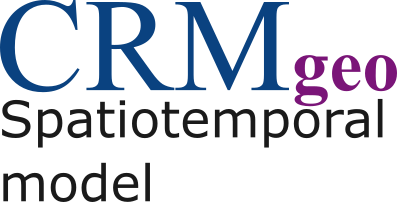|
What is the CRMgeo? CRMgeo is a formal ontology intended to be used as a global schema for integrating spatiotemporal properties of temporal entities and persistent items. Its primary purpose is to provide a schema consistent with the CIDOC CRM to integrate geoinformation using the conceptualizations, formal definitions, encoding standards and topological relations defined by the Open Geospatial Consortium (OGC). In order to do this it links the CIDOC CRM to the OGC standard of GeoSPARQL. CRMgeo provides a refinement of spatial and temporal classes and properties of the CIDOC CRM. It relates them to the classes, topological relations and encodings provided by GeoSPARQL and thus allows spatiotemporal analysis offered by geoinformation systems based on the semantic distinctions of the CIDOC CRM. CRMgeo is a proposal for approval by CIDOC CRM SIG |
What is the idea? Spatial and temporal data used in GIS systems provide an abundance of information that can be very useful for the visualisation and documentation of cultural objects and phenomena. Spatiotemporal properties are often used to prove or establish relations between cultural phenomena (e.g. part-of, co-existence or influence relations) and the Geoinformation community has developed sophisticated analysis methodologies that are often applied to cultural research questions. CRMgeo was created to use the semantics of the CIDOC CRM within such argumentation as they provide relational information independent from spatiotemporal properties. Furthermore, results of spatiotemporal analysis can enrich the argumentation possible within CIDOC CRM semantics. An analysis of OGC concepts and CIDOC CRM concepts revealed that in order to integrate these models the explicit differentiation between spatiotemporal properties of real world phenomena (phenomenal Spacetime Volumes) and human assumptions about these (declarative Spacetime Volumes) is required. Phenomenal Spacetime Volumes derive their identity from phenomena defined as classes in the CIDOC CRM family of models like events or persistent items and are fuzzy due to the nature of the phenomenon. Declarative Spacetime Volumes derive their identity through the expression that defines their place and time on earth (if this is their spatiotemporal reference system). These expressions may be coordinates or derived from measurements. With these ontological distinctions it is possible to relate phenomenal Spacetime Volumes to OGC Features and declarative Spacetime Volumes to OGC Geometries. The differentiation between phenomenal and declarative is applied to CIDOC CRM Places and Time-Spans as well, due to their definition as spatial and temporal projections of a Spacetime Volume. |


